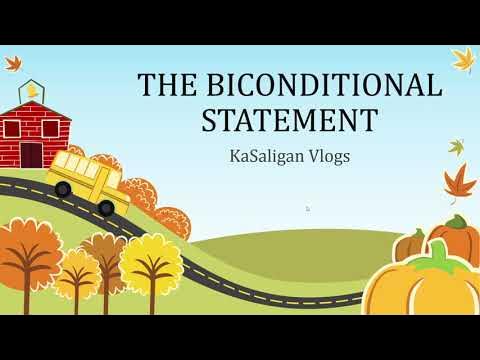CONSTRUCTING A TRUTH TABLE FOR A STATEMENT INVOLVING A CONDITIONAL
Summary
TLDRIn this educational video, the host explains how to construct truth tables for logical statements, specifically focusing on conditional statements (P → Q). The process includes calculating the truth values for various logical operations such as conjunction (P ∧ Q), disjunction (P ∨ Q), negation (¬P), and implications. The video demonstrates how to create truth tables step-by-step, emphasizing the rules of logic for each operation. It provides viewers with a comprehensive guide to understanding propositional logic through practical examples and visual aids, encouraging viewers to try constructing truth tables on their own.
Takeaways
- 😀 Understanding the Conditional Statement: The conditional statement 'If P, then Q' is represented by the arrow notation P → Q.
- 😀 Truth Value of Conditional Statements: The conditional P → Q is false only when P is true and Q is false. In all other cases, it is true.
- 😀 Steps for Constructing a Truth Table: Start by listing all possible combinations of truth values for P and Q (True/False).
- 😀 Negation of P: To evaluate logical expressions, first compute the negation of P (¬P) and use it in subsequent steps.
- 😀 Disjunction (OR): The disjunction of two statements (P ∨ Q) is true if at least one of the statements is true.
- 😀 Conjunction (AND): The conjunction of two statements (P ∧ Q) is true only if both P and Q are true.
- 😀 Key Rule for Disjunction: In disjunctions, if one of the statements is true, the entire expression is true; otherwise, it’s false.
- 😀 Key Rule for Conjunction: In conjunctions, the result is true only when both P and Q are true; otherwise, it’s false.
- 😀 Implication (P → Q): The implication P → Q is true unless P is true and Q is false. It’s false only in that one case.
- 😀 Constructing Complex Statements: Use the basic truth table rules to evaluate complex logical expressions involving negations, conjunctions, and implications.
- 😀 Practical Application: Apply the steps to create truth tables for various logical statements, such as 'P → (Q ∨ ¬P)' to practice and understand logical operations.
Q & A
What is a conditional statement in logic?
-A conditional statement, written as 'P → Q', is read as 'P implies Q' or 'if P, then Q'. It is true in all cases except when P is true and Q is false.
What does the truth table for a conditional statement look like?
-The truth table for 'P → Q' shows the statement as false only when P is true and Q is false. In all other cases, the conditional is true.
How do you calculate the negation of a statement (¬P)?
-The negation of a statement 'P' (written as '¬P') flips the truth value of 'P'. If P is true, ¬P is false; if P is false, ¬P is true.
What is the difference between conjunction (P ∧ Q) and disjunction (P ∨ Q)?
-Conjunction (P ∧ Q) is true only when both P and Q are true. Disjunction (P ∨ Q) is true if at least one of P or Q is true.
When is a conjunction (P ∧ Q) false?
-A conjunction (P ∧ Q) is false if either P or Q is false. It is only true when both P and Q are true.
What is the truth value of a disjunction (P ∨ Q) when both P and Q are false?
-When both P and Q are false, the truth value of the disjunction (P ∨ Q) is false.
Why is the conditional statement 'P → Q' true when P is false, regardless of Q?
-A conditional statement 'P → Q' is always true when P is false, because there is no situation where a false premise (P) can lead to a contradiction.
What happens when both P and Q are true in a conditional statement (P → Q)?
-When both P and Q are true, the conditional statement 'P → Q' is true because the premise (P) holds, and the conclusion (Q) is also true.
How does the truth value of 'P → Q' change if P is true and Q is false?
-When P is true and Q is false, the conditional 'P → Q' is false, as this violates the rule of conditional logic where a true premise must lead to a true conclusion.
What is the purpose of constructing a truth table for a conditional statement?
-The purpose of constructing a truth table for a conditional statement is to systematically evaluate all possible truth values for the components of the statement and determine the overall truth value of the conditional.
Outlines

This section is available to paid users only. Please upgrade to access this part.
Upgrade NowMindmap

This section is available to paid users only. Please upgrade to access this part.
Upgrade NowKeywords

This section is available to paid users only. Please upgrade to access this part.
Upgrade NowHighlights

This section is available to paid users only. Please upgrade to access this part.
Upgrade NowTranscripts

This section is available to paid users only. Please upgrade to access this part.
Upgrade NowBrowse More Related Video

CONVERSE, INVERSE AND CONTRAPOSITIVE OF IF - THEN STATEMENTS || GRADE 8 MATHEMATICS Q2

PEMBUKTIAN RUMUS LOGIKA MATEMATIKA PADA PENALARAN UMUM UTBK 2020

2.2 Notes Part 2

EQUIVALENT STATEMENTS | De Morgan's Law for Statements

THE BICONDITIONAL STATEMENT (LOGIC- MATHEMATICS IN THE MODERN WORLD)

Logika Matematika - Penarikan Kesimpulan
5.0 / 5 (0 votes)